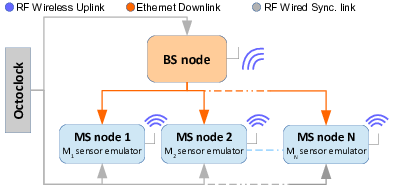Section: New Results
Results of axis 3: experimental assessment
During 2019-2020, our experimental work was mostly devoted to the development of new functions of FIT/CorteXlab, and to the development of experimental evaluations with external partners.
-
Development of a user and administrative graphical interface
Table 9. Principal Investigator: Pascal Girard, Matthieu Imbert, Léonardo Cardoso Funding: FIT/CorteXlab Partners: FIT consortium The objective is to develop a web-based user-friendly interface for using CorteXlab. Several modules are planned and the first module is the user management module, which aims at easing platform usage and improving the metadata that we can associate with each experimenter and experiment. This metadata aims at improving the metrics we can gather about the platform's usage.
-
Development of a docker-based experiment conducting middleware.
Table 10. Principal Investigator: Matthieu Imbert, Léonardo Cardoso Funding: FIT/CorteXlab Partners: FIT consortium CorteXlab relies on Minus, an experiment conducting middleware which allows users to submit experimental tasks to the platform, handles the automatic execution of these experiments, and gathers their results. The initial design for Minus relies on a fixed toolchain (mainly composed of GNURadio, hardware drivers, and additional external or in-house software or GNURadio blocks, FPGA tools, etc.). Experimenters are supposed to use this fixed toolchain in a batch-like workflow. It is hard for experimenters to extend the limits of the fixed toolchain (e.g. to use a custom library or software, or a different version of GNURadio), and the development phase of an experiment can be painful due to the batch-like interface. To improve this, we have developed a new experimental workflow based on docker [61] images and containers which allows experimenters to use our in-house provided docker images [52], adapt them if needed, or even create completely custom ones. These images have the benefit that they can be used identically on the experimenters' workstations, on the CorteXlab platform, or another platform, and they can be used interactively if needed, even on CorteXlab. This increases greatly the ease of use of the platform, the reproducibility and share-ability of experiments, and the breadth of its usage.
-
Reference scenario for massive IoT access
Table 11. Principal Investigator: Othmane Oubejja, Jean-Marie Gorce Matthieu Imbert, Léonardo Cardoso Funding: ANR Ephyl, ANR ARburst Partners: CEA Leti, Supelec Rennes, Sequans Publications: [46] In this work we developed an experimental setup for dense IoT access evaluation, as part of the project ”Enhanced Physical Layer for Cellular IoT” (EPHYL), using FIT/CorteXlab radio testbed. The aim of this work is to provide a customizable and open source design for IoT networks prototyping in a massive multi-user, synchronized and reproducible environment thanks to the hardware and software capabilities of the testbed. The massive access feature is managed by emulating a base station and several sensors per radio nodes. As shown in Fig.4, two categories of modular network components are used in our design: a base station unit and a multi-sensor emulator unit. These components are separately hosted in dedicated and remotely accessible radio nodes.
The features of this design can be accessed through customizable demos as documentation and resources are available online. As a result, it is possible for any interested user to plug custom algorithms, evaluate diverse communication scenarios and perform necessary physical measurements.



